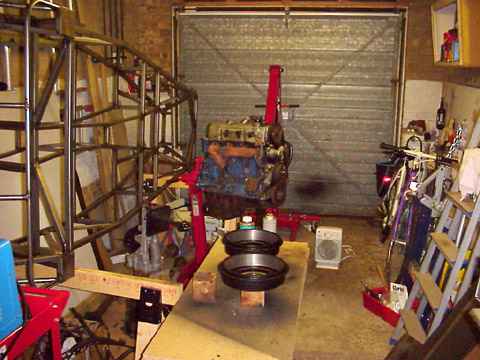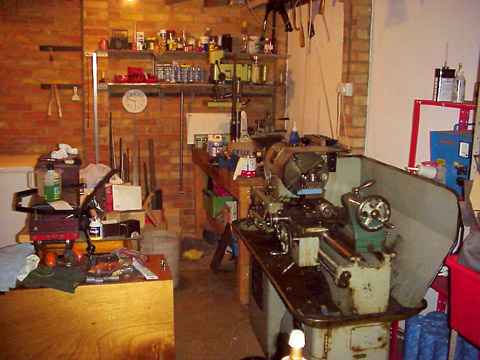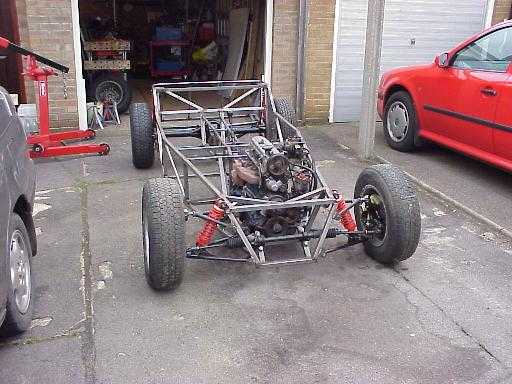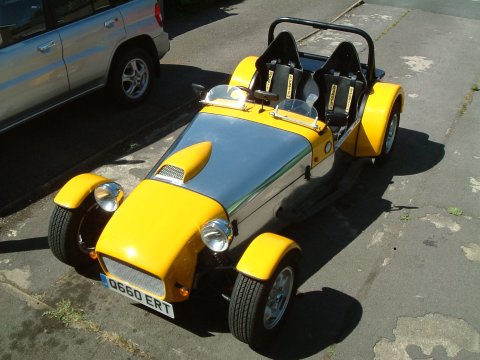

Having decided in 1997 that I was going to build a sports car, I started to look around for somewhere to buy the materials. This proved to be the first of many problems, as East Anglia is not noted for its industrial heritage! I finally tracked down a local steel stockist who sold me the steel tubing. It comes as quite a shock when you see this small pile of square and round tubing and realise that this will form the major part of the car.
I cleared the garage, put down the baseboard and started marking out. This is where I started to realise that the book has a number of inaccuracies! Fortunately, it became apparent that most of the errors were in the Imperial measurements - I stuck to metric, and had few problems from then on.
Once the major part of the chassis was complete, I started on the suspension parts. Here I followed the book closely, apart from having to use one-eighth wall tubing instead of one-sixteenth - you wouldn't believe the problems that caused! Still, all came right in the end.
Finally, a local garage sold me an engine, 5-speed gearbox and steering column from a 1.6 Sierra... which is where I started to have problems.
The biggest problem I had from the beginning was a lack of space. I have what is laughingly called a "double garage" but, unfortunately, it is double length rather than double width. As you can see from the photos, manoeuvering room is a severe problem, and I often had to move stuff out into the driveway before I could work. This could only be done when it wasn't raining.


Finally, after some difficulty in getting the rear wheels to fit (10mm spacers were used to clear the swinging arms), and getting the correct 'Ghia' wheel nuts, the beast was rolled out of the garage. (Eventually I got some 'real' proper-sized wheels from Superlite that didn't require spacers.)

But then I changed my mind! I decided that I didn't want to invest a heap of money in the 1600 Pinto lump - my choices were to get a 2 litre Pinto (and have to muck around with my gearbox as well), or to look for the 1600cc Crossflow I originally wanted. By happy coincidence Tony Dwornik (Dwornik Engineering) had a suitable lump from an automatic MkII Escort, which was duly purchased and taken home.
This engine was stripped and refurbished. It was not significantly tuned, being GT specification internally, with a Kent BCF2 cam, a Weber DGAV 32/36 downdraft carb and a better exhaust manifold (also from Dwornik Engineering). This is all within my overall objective, which was to get a fast but manageable sports car.
The effect of the change was to make it a lot easier to fit the engine into the small space under the bonnet - the Pinto is a tall engine, which means that the sump needs to be chopped and the oil pickup pipe modified, and (usually) a hump needs to be added to the bonnet. For anyone contemplating a Pinto, don't waste your time with a 1600cc lump - go for 2000cc, which has sufficient advantages to compensate for its size and weight. If you want a 1600cc, get a crossflow (or go smaller and get a Honda Fireblade engine!).
The completed chassis was taken to the plastic coaters on the specially made "Locost" transporter.
All panels were fitted to the book design. I had to replace my radiator to fit a new nose-cone, which set the schedule back a lot. The wiring loom was designed while travelling to and from London every day. The wiring worked out very well, with just a couple of minor errors to be fixed after wiring up. The dashboard was made as part of this work, using instruments from CA (a.k.a. Smiths). The cockpit area has been trimmed out fairly simply, with plain vinyl and rubber mats.
The engine eventually ran, which was very gratifying! In the end it ran really well, after suffering from a significant cock-up on the ignition front - I was trying to use a contact-breaker distributor with an ignition coil designed for use with an electronic distributor - it gave enough sparks to let the engine run, but not enough to sustain proper running. To fix this problem I fitted a Bosch distributor from a Mk 3 Escort, using the instructions from Wallage's X-flow book. Unfortunately, his instructions were wrong! After swapping the black and green wires the engine ran very sweetly.


It's passed the SVA in October 2005, and it's now done about 14,500 miles. It is still getting fiddled with - this car will never be finished!